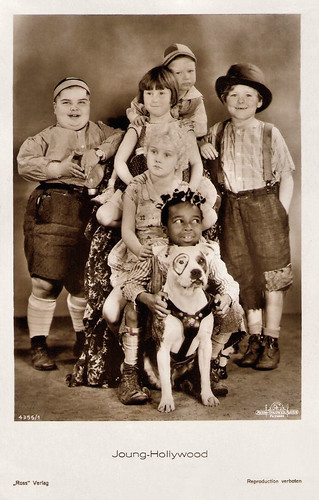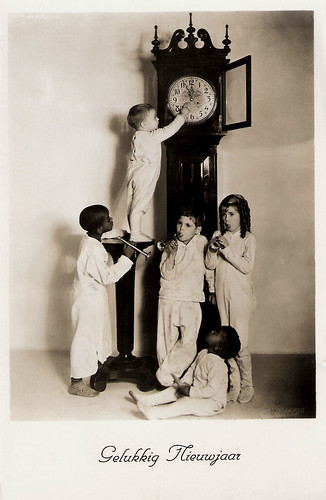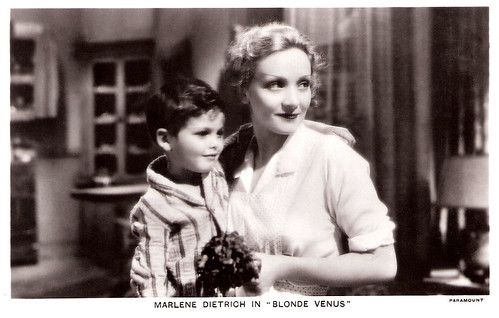Recently two of the 'Little Rascals' of the Our Gang comedies have died. On 4 September 2015, Blonde Jean Darling (1922-2015) passed away at 93. She was, along with Baby Peggy, one of the last surviving actors who worked in the silent film era. Three days later, she was followed by Dickie Moore (1925-2015), who died at the age of 89.

German postcard by Ross Verlag, no. 4356/1, 1929-1930. Photo: Metro-Goldwyn-Mayer. Publicity still of Our Gang with Jean Darling, the blonde girl.

Dutch postcard. Photo: a publicity shot of the Little Rascals a.k.a. Our Gang with Dickie Moore in the middle. Caption: "Gelukkig Nieuwjaar" (Happy New Year).
Jean Darling was born as Dorothy Jean LeVake in 1922. Her name was legally changed to Jean Darling when she was five months old, a few days after her mother and father split. At six months old she started her screen career during the silent era as a freelance baby. She got her break in 1926 when she passed a screen test and was accepted for a part in Hal Roach's Our Gang series. Darling appeared in 46 silents and six talkies with Our Gang during this period.
Our Gang, also known as The Little Rascals, is a series of American comedy short films about a group of poor neighbourhood children and their adventures. Created by comedy producer Hal Roach, the series is noted for showing children behaving in a relatively natural way, as Roach and original director Robert F. McGowan worked to film the unaffected, raw nuances apparent in regular children rather than have them imitate adult acting styles. In addition, Our Gang notably put boys, girls, whites and blacks together as equals.
The franchise began in 1922 as a series of silent short subjects produced by the Roach studio and released by Pathé Exchange. Roach changed distributors from Pathé to Metro-Goldwyn-Mayer (MGM) in 1927, and the series entered its most popular period after converting to sound in 1929.
Jean Darling played in the Little Rascals shorts till 1929. Later she appeared with Laurel & Hardy in a bit role in Babes in Toyland (Gus Meins, Charley Rogers, 1934) and as the young Jane in Jane Eyre (Christy Cabanne, 1934).
Having toured the world with her husband, Kajar the Magician's Show Magicadabr, Jean Darling settled in Dublin and became an author of dozens of short mysteries and horror fantasy for magazines. In 1980 she became Aunty Poppy writing and telling over 450 children's stories on both RTE radio and TV. Before her death, she was one of four surviving cast members from the silent era cast of Our Gang. The others are Lassie Lou Ahern, Mildred Kornman and Dorothy Morrison.

British postcard, distributed in the Netherlands by M. Bonnist & Zonen, Amsterdam, no, 136e. Photo: Paramount. Publicity still of Marlene Dietrich and Dickie Moore in Blonde Venus (Josef von Sternberg, 1932).

Dutch postcard by JosPe, no. 327, ca. 1932. Photo: Paramount. Publicity still of Marlene Dietrich, Herbert Marshall (and not Cary Grant as credited!) and Dickie Moore in Blonde Venus (Josef von Sternberg, 1932).
Dickie Moore already made his screen debut as a baby in the John Barrymore film The Beloved Rogue (1927).
He played the little son of Marlene Dietrich in Blonde Venus (Josef von Sternberg, 1932) and then was one of the regulars in the Our Gang comedies for a year (1932-1933).
By the time he had turned 10, he was a popular child star and had appeared in 52 films. Later, he gave 14-year-old Shirley Temple her first screen kiss - in Miss Annie Rooney (Edwin L. Marin, 1942). Then the roles began to dry up, and he made his last film in 1950.
Moore worked as a public relations executive and produced industrial shows. He was the Author of Twinkle, Twinkle Little Star (But Don't Have Sex or Take the Car) in which he interviewed 31 ex-child actors, more than half of whom found their adult lives beset by alcoholism, nervous breakdowns, or failed first marriages. Besides his third and last wife, film actress Jane Powell, Moore is survived by a son, Kevin; a stepson, Geary; two stepdaughters, Lindsay and Suzanne; a sister, Pat Kingsley; and several grandchildren and step-grandchildren.
And how did Our Gang end on screen? Production of the series continued at the Hal Roach studio until 1938. Then the series was sold to MGM, which produced the comedies itself until 1944. In total, the Our Gang series includes 220 shorts and one feature film, General Spanky, featuring over forty-one child actors.
Sources: IMDb and Wikipedia.
This post was last updated on 11 August 2024.

German postcard by Ross Verlag, no. 4356/1, 1929-1930. Photo: Metro-Goldwyn-Mayer. Publicity still of Our Gang with Jean Darling, the blonde girl.

Dutch postcard. Photo: a publicity shot of the Little Rascals a.k.a. Our Gang with Dickie Moore in the middle. Caption: "Gelukkig Nieuwjaar" (Happy New Year).
Jean Darling
Jean Darling was born as Dorothy Jean LeVake in 1922. Her name was legally changed to Jean Darling when she was five months old, a few days after her mother and father split. At six months old she started her screen career during the silent era as a freelance baby. She got her break in 1926 when she passed a screen test and was accepted for a part in Hal Roach's Our Gang series. Darling appeared in 46 silents and six talkies with Our Gang during this period.
Our Gang, also known as The Little Rascals, is a series of American comedy short films about a group of poor neighbourhood children and their adventures. Created by comedy producer Hal Roach, the series is noted for showing children behaving in a relatively natural way, as Roach and original director Robert F. McGowan worked to film the unaffected, raw nuances apparent in regular children rather than have them imitate adult acting styles. In addition, Our Gang notably put boys, girls, whites and blacks together as equals.
The franchise began in 1922 as a series of silent short subjects produced by the Roach studio and released by Pathé Exchange. Roach changed distributors from Pathé to Metro-Goldwyn-Mayer (MGM) in 1927, and the series entered its most popular period after converting to sound in 1929.
Jean Darling played in the Little Rascals shorts till 1929. Later she appeared with Laurel & Hardy in a bit role in Babes in Toyland (Gus Meins, Charley Rogers, 1934) and as the young Jane in Jane Eyre (Christy Cabanne, 1934).
Having toured the world with her husband, Kajar the Magician's Show Magicadabr, Jean Darling settled in Dublin and became an author of dozens of short mysteries and horror fantasy for magazines. In 1980 she became Aunty Poppy writing and telling over 450 children's stories on both RTE radio and TV. Before her death, she was one of four surviving cast members from the silent era cast of Our Gang. The others are Lassie Lou Ahern, Mildred Kornman and Dorothy Morrison.

British postcard, distributed in the Netherlands by M. Bonnist & Zonen, Amsterdam, no, 136e. Photo: Paramount. Publicity still of Marlene Dietrich and Dickie Moore in Blonde Venus (Josef von Sternberg, 1932).

Dutch postcard by JosPe, no. 327, ca. 1932. Photo: Paramount. Publicity still of Marlene Dietrich, Herbert Marshall (and not Cary Grant as credited!) and Dickie Moore in Blonde Venus (Josef von Sternberg, 1932).
Dickie Moore
Dickie Moore already made his screen debut as a baby in the John Barrymore film The Beloved Rogue (1927).
He played the little son of Marlene Dietrich in Blonde Venus (Josef von Sternberg, 1932) and then was one of the regulars in the Our Gang comedies for a year (1932-1933).
By the time he had turned 10, he was a popular child star and had appeared in 52 films. Later, he gave 14-year-old Shirley Temple her first screen kiss - in Miss Annie Rooney (Edwin L. Marin, 1942). Then the roles began to dry up, and he made his last film in 1950.
Moore worked as a public relations executive and produced industrial shows. He was the Author of Twinkle, Twinkle Little Star (But Don't Have Sex or Take the Car) in which he interviewed 31 ex-child actors, more than half of whom found their adult lives beset by alcoholism, nervous breakdowns, or failed first marriages. Besides his third and last wife, film actress Jane Powell, Moore is survived by a son, Kevin; a stepson, Geary; two stepdaughters, Lindsay and Suzanne; a sister, Pat Kingsley; and several grandchildren and step-grandchildren.
And how did Our Gang end on screen? Production of the series continued at the Hal Roach studio until 1938. Then the series was sold to MGM, which produced the comedies itself until 1944. In total, the Our Gang series includes 220 shorts and one feature film, General Spanky, featuring over forty-one child actors.
Sources: IMDb and Wikipedia.
This post was last updated on 11 August 2024.
No comments:
Post a Comment